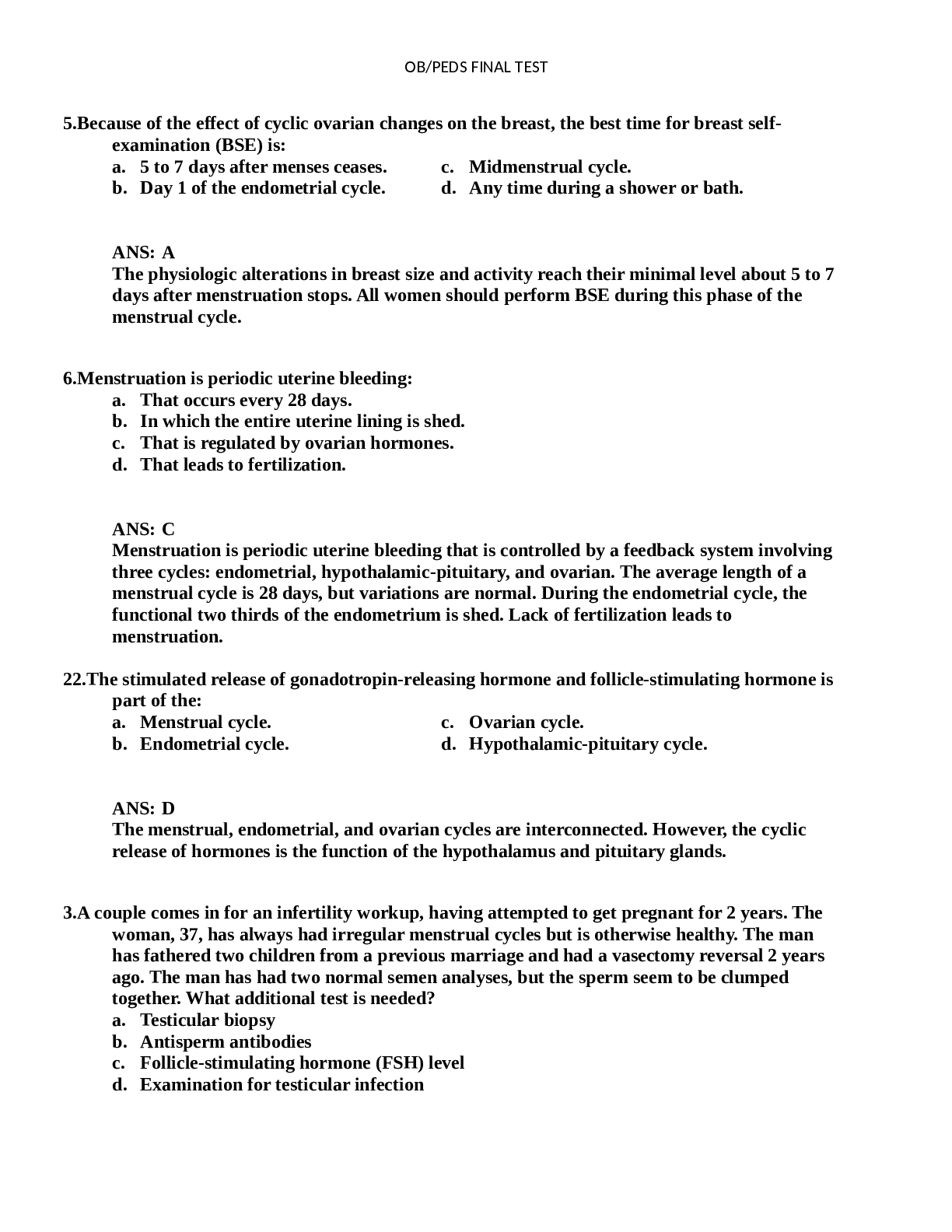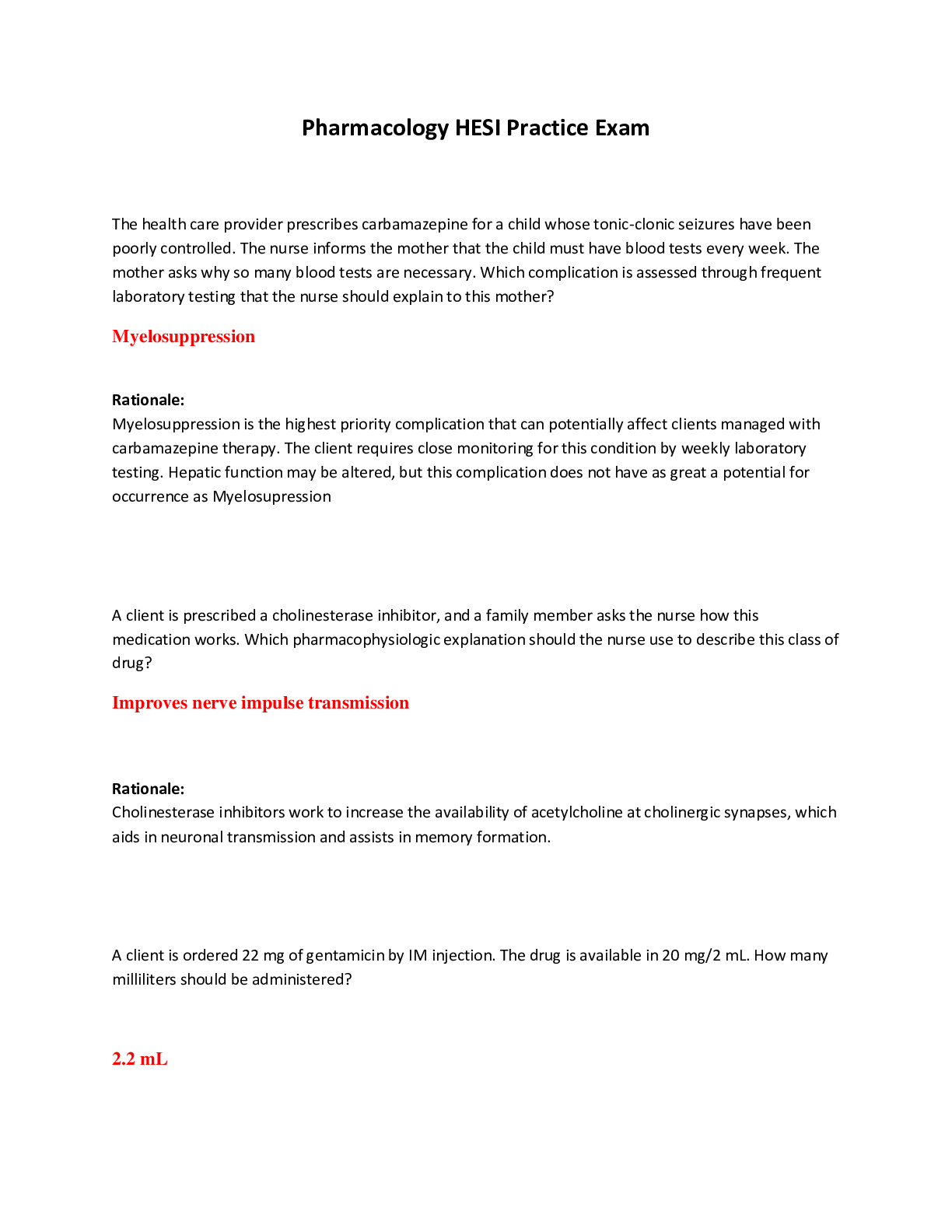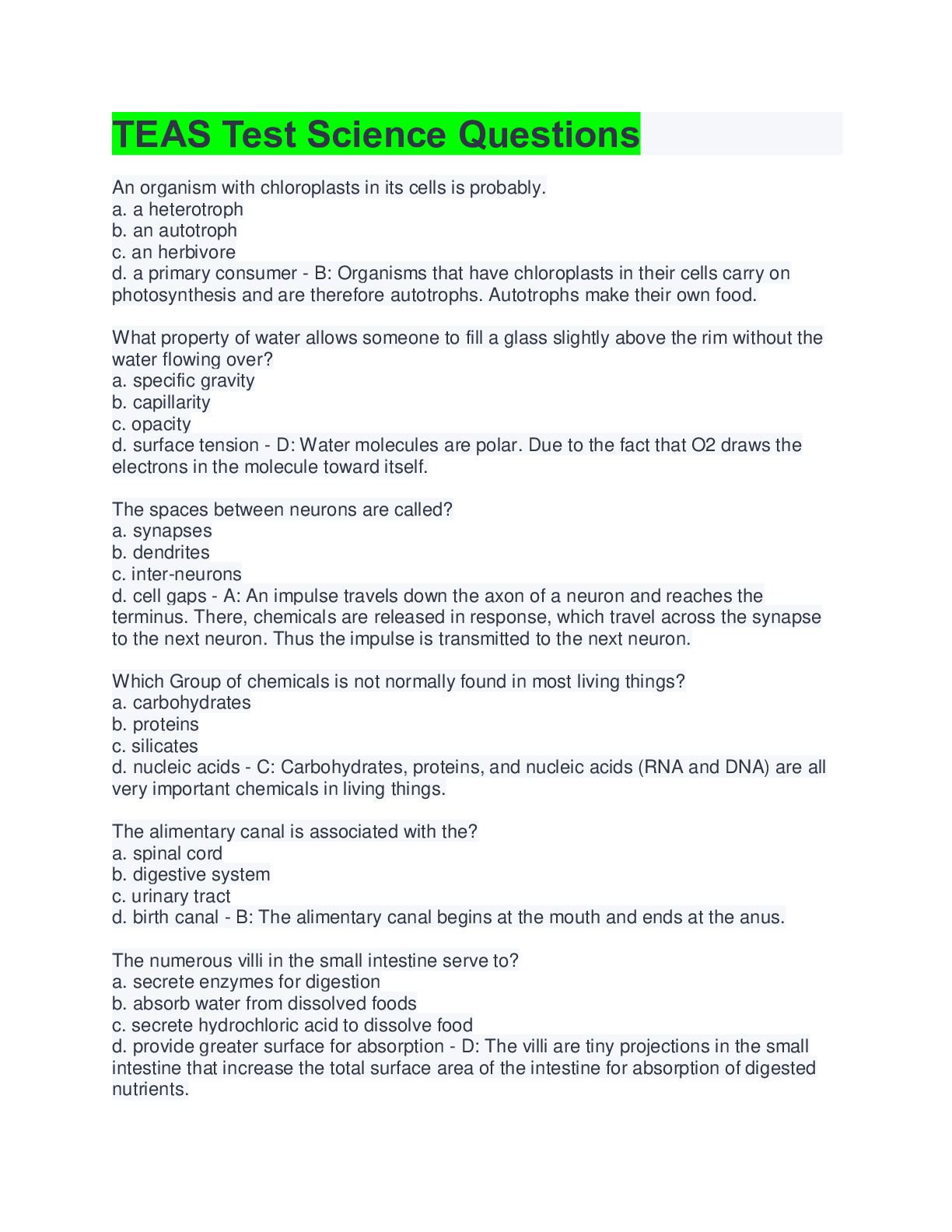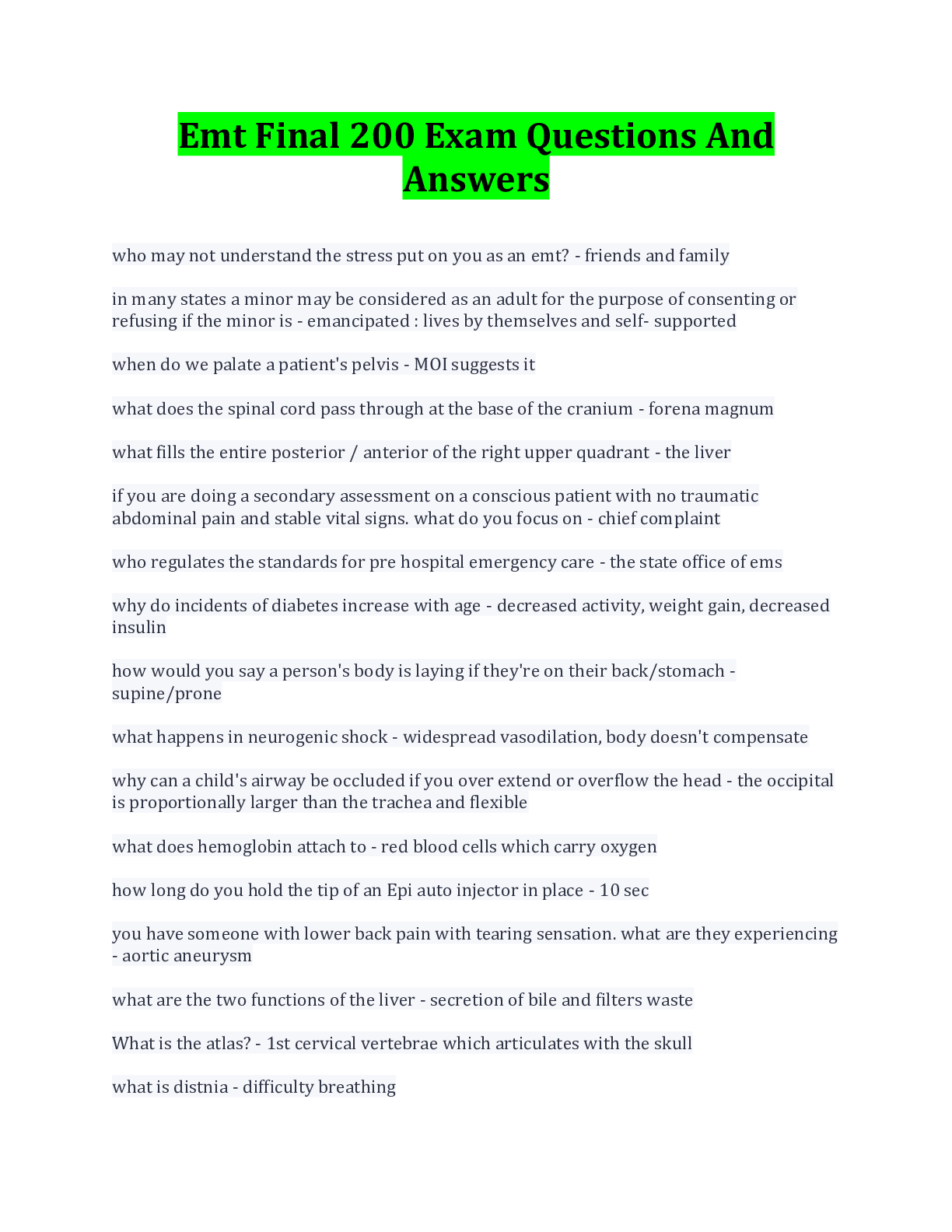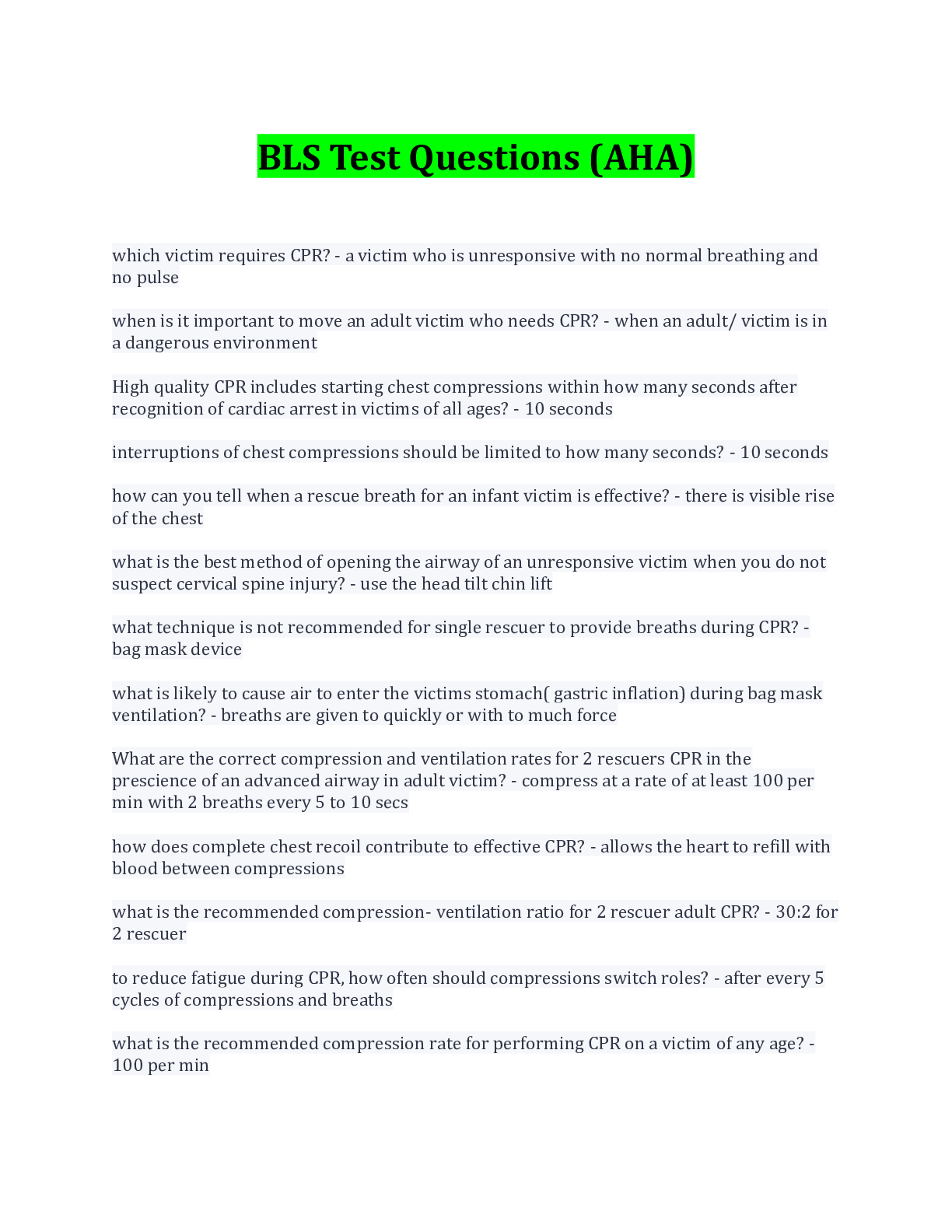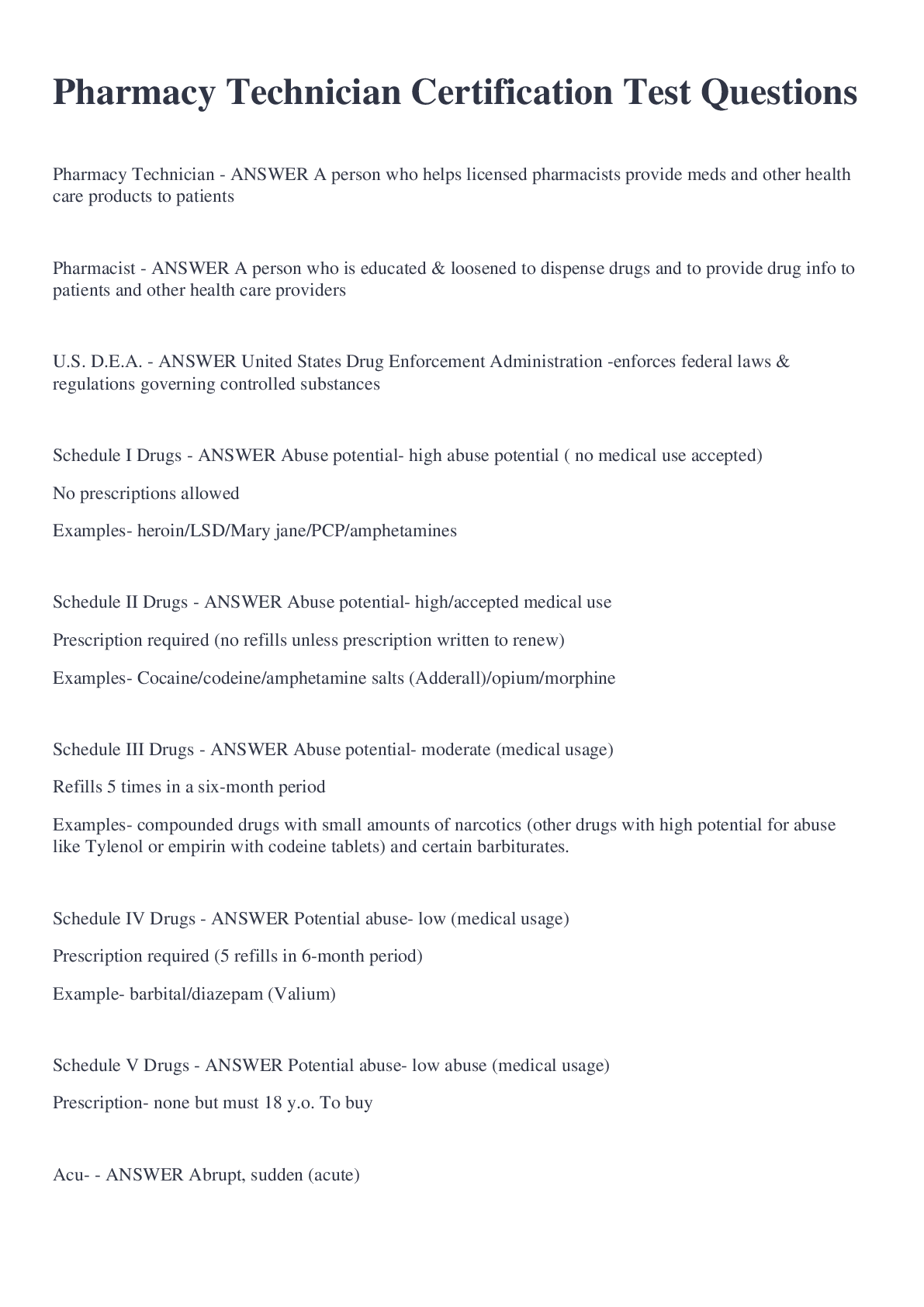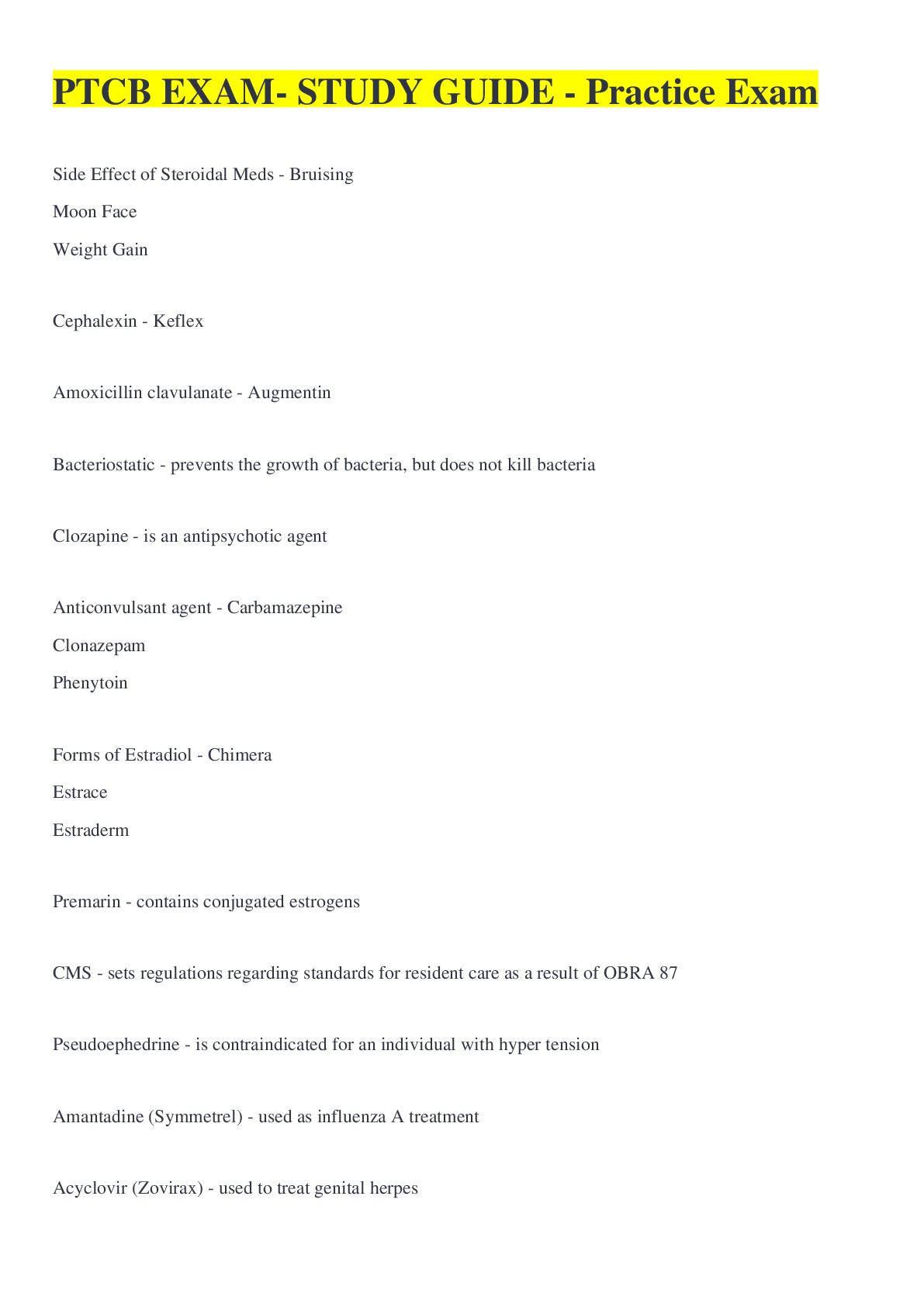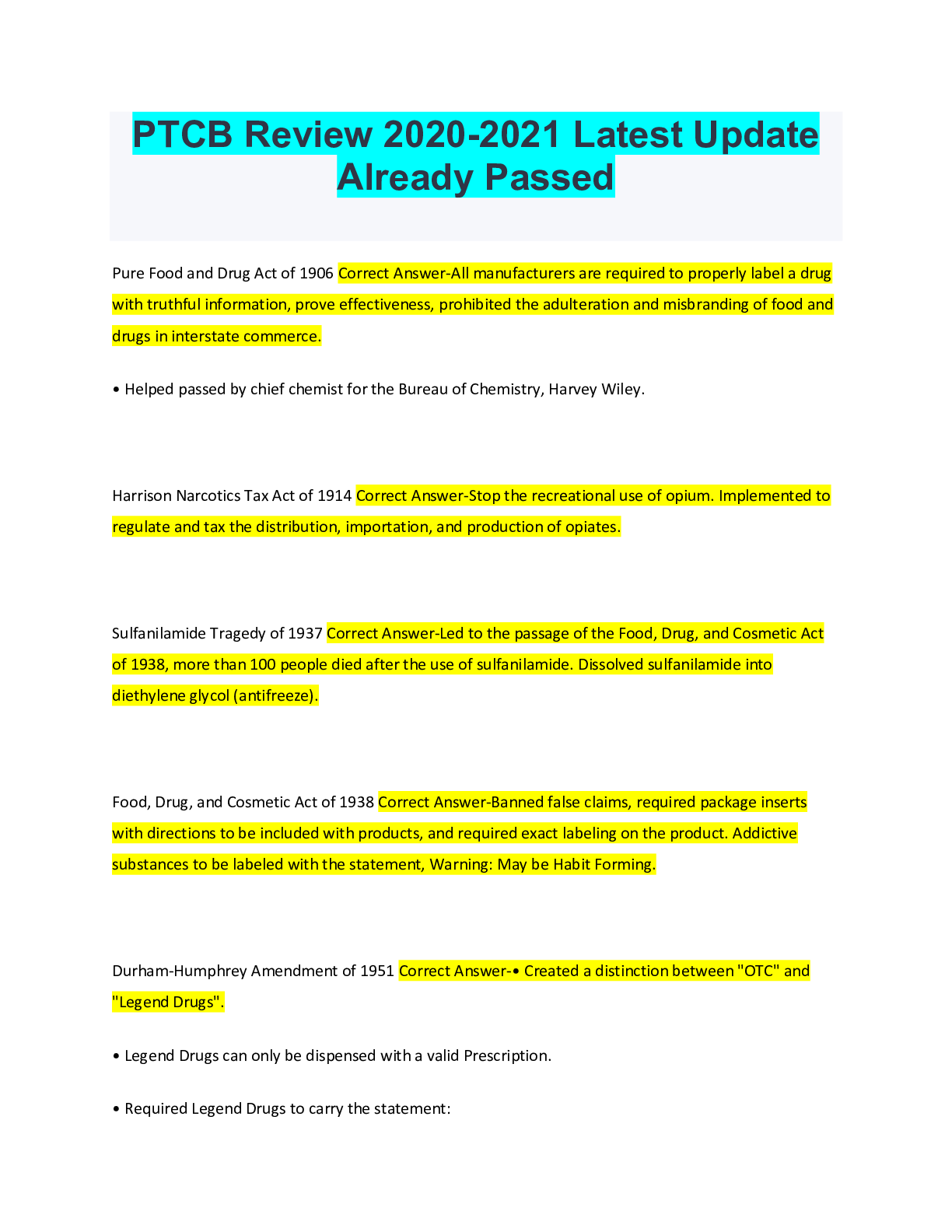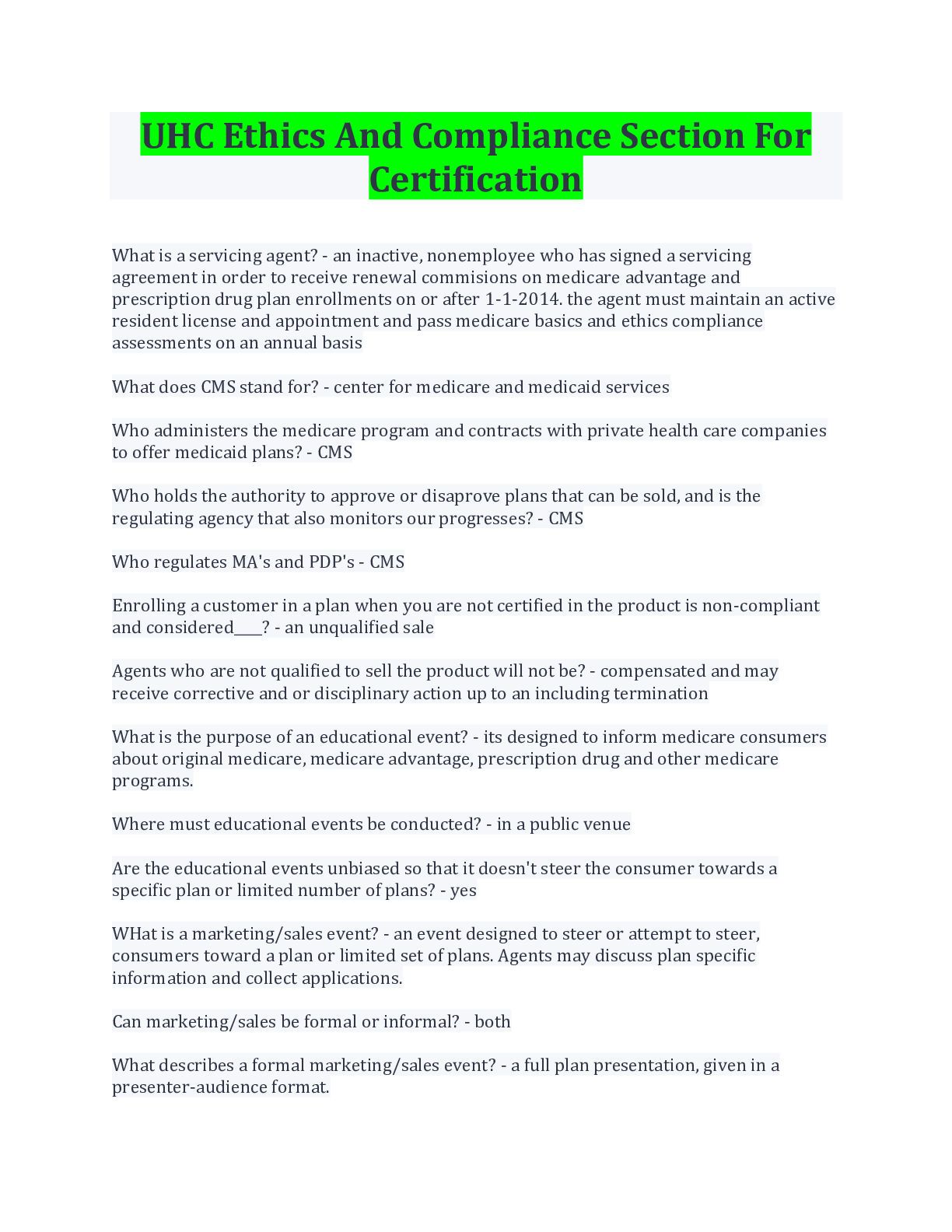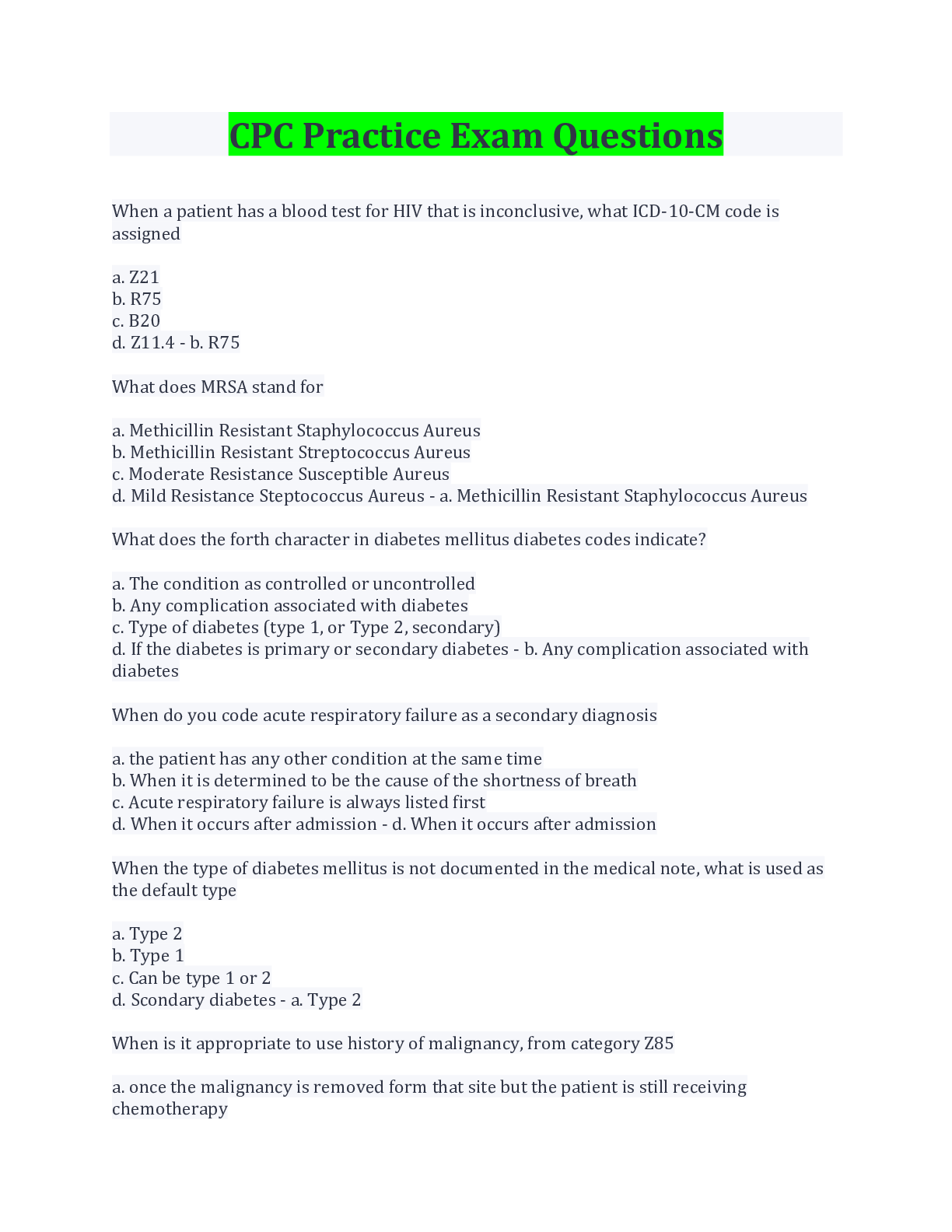*NURSING > EXAM > Hesi Fundamentals 2019 Exam Questions And Answers( Complete Solution Rated A) (All)
Hesi Fundamentals 2019 Exam Questions And Answers( Complete Solution Rated A)
Document Content and Description Below
Hesi Fundamentals 2019 Exam Questions HESI FUNDAMENTALS 2019 EXAM 1. The home health nurse visits an elderly female client who had a brain attack three months ago and is now able to ambulate with th... e assistance of a quad cane. Which assessment finding has the greatest implications for this client's care? • The husband, who is the caregiver, begins to weep when the nurse asks how he is doing. • The client tells the nurse that she does not have much of an appetite today. • The nurse notes that there are numerous scatter rugs throughout the house. Correct • The client's pulse rate is 10 beats higher than it was at the last visit one week ago. Scatter rugs (C) pose a safety hazard because the client can trip on them when ambulating, so this finding has the greatest significance in planning this client's care. Psychological support of the caregiver (A) is a less acute need than that of client safety. The nurse needs to obtain more information about (B), but this is not a safety issue. (D) is not a significant increase, and additional assessment might provide information about the reason for the increase (anxiety, exercise, etc.). 2. The nurse is digitally removing a fecal impaction for a client. The nurse should stop the procedure and take corrective action if which client reaction is noted? • Temperature increases from 98.8° to 99.0° F. • Pulse rate decreases from 78 to 52 beats/min. Correct • Respiratory rate increases from 16 to 24 breaths/min. • Blood pressure increases from 110/84 to 118/88 mm/Hg. Parasympathetic reaction can occur as a result of digital stimulation of the anal sphincter, which should be stopped if the client experiences a vagal response, such as bradycardia (B). (A, C, and D) do not warrant stopping the procedure. 3. The nurse is providing passive range of motion (ROM) exercises to the hip and knee for a client who is unconscious. After supporting the client's knee with one hand, what action should the nurse take next? • Raise the bed to a comfortable working level. • Bend the client's knee. • Move the knee toward the chest as far as it will go. • Cradle the client's heel. Correct Passive ROM exercise for the hip and knee is provided by supporting the joints of the knee and ankle (D) and gently moving the limb in a slow, smooth, firm but gentle manner. (A) should be done before the exercises are begun to prevent injury to the nurse and client. (B) is carried out after both joints are supported. After the knee is bent, then the knee is moved toward the chest to the point of resistance (C) two or three times. 4. A client who has moderate, persistent, chronic neuropathic pain due to diabetic neuropathy takes gabapentin (Neurontin) and ibuprofen (Motrin, Advil) daily. If Step 2 of the World Health Organization (WHO) pain relief ladder is prescribed, which drug protocol should be implemented? • Continue gabapentin. Correct • Discontinue ibuprofen. • Add aspirin to the protocol. • Add oral methadone to the protocol. Based on the WHO pain relief ladder, adjunct medications, such as gabapentin (Neurontin), an antiseizure medication, may be used at any step for anxiety and pain management, so (A) should be implemented. Nonopiod analgesics, such as ibuprofen (A) and aspirin (C) are Step 1 drugs. Step 2 and 3 include opioid narcotics (D), and to maintain freedom from pain, drugs should be given around the clock rather than by the client s PRN requests. 5. The nurse is preparing to irrigate a client's indwelling urinary catheter using an open technique. What action should the nurse take after applying gloves? • Empty the client's urinary drainage bag. • Draw up the irrigating solution into the syringe. Correct • Secure the client's catheter to the drainage tubing. • Use aseptic technique to instill the irrigating solution. To irrigate an indwelling urinary catheter, the nurse should first apply gloves, then draw up the irrigating solution into the syringe (B). The syringe is then attached to the catheter and the fluid instilled, using aseptic technique (D). Once the irrigating solution is instilled, the client's catheter should be secured to the drainage tubing (C). The urinary drainage bag can be emptied (A) whenever intake and output measurement is indicated, and the instilled irrigating fluid can be subtracted from the output at that time. 6. Which client care requires the nurse to wear barrier gloves as required by the protocol for Standard Precautions? • Removing the empty food tray from a client with a urinary catheter. • Washing and combing the hair of a client with a fractured leg in traction. • Administering oral medications to a cooperative client with a wound infection. • Emptying the urinary catheter drainage bag for a client with Alzheimer's disease. Correct Possible contact with body secretions, excretions, or broken skin is an indication for wearing barrier (nonsterile) gloves. Emptying a urine drainage bag requires the use of gloves (D). (A, B, and C) do not require gloves. 7. What action should the nurse implement to prevent the formation of a sacral ulcer for a client who is immobile? • Maintain in a lateral position using protective wrist and vest devices. • Position prone with a small pillow below the diaphragm. Correct • Raise the head and knee gatch when lying in a supine position. • Transfer into a wheelchair close to the nurse's station for observation. The prone position (B) using a small pillow below the diaphragm maintains alignment and provides the best pressure relief over the sacral bony prominence. Using protective (restraining) devices (A) is not indicated. Raising the head and bed gatch (C) may reduce shearing forces due to sliding down in bed, but it interferes with venous return from the legs and places pressure on the sacrum, predisposing to ulcer formation. Sitting in a wheelchair (D) places the body weight over the ischial tuberosities and predisposes to a potential pressure point. 8. What intervention should the nurse include in the plan of care for a client who is being treated with an Unna's paste boot for leg ulcers due to chronic venous insufficiency? • Check capillary refill of toes on lower extremity with Unna's paste boot. Correct • Apply dressing to wound area before applying the Unna's paste boot. • Wrap the leg from the knee down towards the foot. • Remove the Unna's paste boot q8h to assess wound healing. The Unna's paste boot becomes rigid after it dries, so it is important to check distally for adequate circulation (A). Kerlix is often wrapped around the outside of the boot and an ace bandage may be used to cover both, but no bandage should be put under it (B). The Unna's paste boot should be applied from the foot and wrapped towards the knee (C). The Unna's paste boot acts as a sterile dressing, and should not be removed q8h. Weekly removal is reasonable (D). 9. The nurse is administering an intermittent infusion of an antibiotic to a client whose intravenous (IV) access is an antecubital saline lock. After the nurse opens the roller clamp on the IV tubing, the alarm on the infusion pump indicates an obstruction. What action should the nurse take first? • Check for a blood return. • Reposition the client's arm. Correct • Remove the IV site dressing. • Flush the lock with saline. If the client's elbow is bent, the IV may be unable to infuse, resulting in an obstruction alarm, so the nurse should first attempt to reposition the client's arm to alleviate any obstruction (B). After other sources of occlusion are eliminated, the nurse may need to check for a blood return (A), remove the dressing (C), or flush the saline lock (D) and then resume the intermittent infusion. 10. A female client who has breast cancer with metastasis to the liver and spine is admitted with constant, severe pain despite around-the-clock use of oxycodone (Percodan) and amitriptyline (Elavil) for pain control at home. During the admission assessment, which information is most important for the nurse to obtain? • Sensory pattern, area, intensity, and nature of the pain. Correct • Trigger points identified by palpation and manual pressure of painful areas. • Schedule and total dosages of drugs currently used for breakthrough pain. • Sympathetic responses consistent with onset of acute pain. The components of every pain assessment should include sensory patterns, area, intensity, and nature (PAIN) of the pain (A) and are essential in identifying appropriate therapy for the client's specific type and severity of pain, which may indicate the onset of disease progression or complications. Triggers (B), current drug usage (C), and sympathetic responses (D), such as tachycardia, diaphoresis, and elevated blood pressure, are important, but should be obtained after focusing on (A). 11. A male client is on contact precautions due to an infected draining wound and is being discharged home. The client lives at home with his wife and their adolescent daughter. What discharge instruction should the nurse include for the client? • Use disposable plates and utensils. • Stay in a room with the door closed. • Dispose of soiled dressings in plastic bags that are securely closed. Correct • Others who are in the same room with the client should wear a mask. Contact precautions require the use of a barrier that prevents contact with wound secretions on soiled dressings, which are best disposed of in tightly closed plastic bags (C). (A) is not necessary with contact precautions. (B and D) should be implemented for airborne, droplet precautions, or protective environments. 12. The nurse is discussing dietary preferences with a client who adheres to a vegan diet. Which dietary supplement should the nurse encourage the client to include the dietary plan? • • • Ascorbic acid. • Vitamin B12. Correct Vitamin B12 is normally found in liver, kidney, meat, fish and dairy products. A vegan who consumes only vegetables without careful dietary planning and supplementation may develop peripheral neuropathy due to a deficiency in vitamin B12 (D). (A, B, and C) are commonly adequate in vegtables and fruits. 13. The charge nurse observes that a demographic screen has been left open on a hallway computer by a nurse who is responding to a call light because the unlicensed assistive personnel (UAP) is involved in a personal phone call. Which action should the charge nurse take first? • Page the unit manager to address the situation. • Close the demographic screen on the computer. Correct • Instruct the UAP to end the phone call immediately. • Send a UAP into the client's room to relieve the nurse. The greatest priority is for the charge nurse to close the computer screen (B), because health information stored in computerized systems is considered to be Protected Health Information (PHI) under HIPAA (Health Insurance Portability and Accountability Act). (A, C, and D) may be indicated, but are of less priority than (B). 14. A female client informs the nurse that she uses herbal therapies to supplement her diet and manage common ailments. What information should the nurse offer the client about general use of herbal supplements? • Most herbs are toxic or carcinogenic and should be used only when proven effective. • There is no evidence that herbs are safe or effective as compared to conventional supplements in maintaining health. • Herbs should be obtained from manufacturers with a history of quality control of their supplements. Correct • Herbal therapies may mask the symptoms of serious disease, so frequent medical evaluation is required during use. The current availability of many herbal supplements lacks federal regulation, research, control and standardization in the manufacture of its purity and dose. Manufacturers that provide evidence of quality control (C), such as labeling that contains scientific generic name, name and address of the manufacturer, batch or lot number, date of manufacture, and expiration date, is the best information to provide. (A, B, and D) are misleading. 15. A high school senior is complaining of a persistent cough and admits to smoking 10 to 15 cigarettes daily for the past year. He is convinced that he is hopelessly addicted to tobacco since he tried unsuccessfully to quit smoking last week. Which intervention is best for the nurse to implement? • Encourage the student to associate with non-smokers only while attempting to stop smoking. Correct • Tell the student that he is still young and should continue to try various smoking cessation methods. • Describe cigarette smoking as a habit that requires a strong will to overcome its addictiveness. • Provide the student with the latest research data describing the long-term effects of tobacco use. It is difficult to cease smoking when surrounded by those who smoke, and adolescents are particularly influenced by peers, so (A) is the most important intervention for the nurse to implement. (B) is not likely to be helpful and offers no concrete suggestions for smoking cessation. (C) is condescending. Risks associated with smoking must already be known to this adolescent who is already attempting to stop the habit (D). Category: Fundamentals 16. When making the bed of a client who needs a bed cradle, which action should the nurse include? • Teach the client to call for help before getting out of bed. • Keep both the upper and lower side rails in a raised position. • Keep the bed in the lowest position while changing the sheets. • Drape the top sheet and covers loosely over the bed cradle. Correct A bed cradle is used to keep the top bedclothes off the client, so the nurse should drape the top sheet and covers loosely over the cradle (D). A client using a bed cradle may still be able to ambulate independently (A) and does not require raised side rails (B). (C) causes the nurse to use poor body mechanics. 17. A male client with acquired immunodeficiency syndrome (AIDS) develops cryptococcal meningitis and tells the nurse he does not want to be resuscitated if his breathing stops. What action should the nurse implement? • Document the client's request in the medical record. • Ask the client if this decision has been discussed with his healthcare provider. Correct • Inform the client that a written, notarized advance directive, is required to withhold resuscitation efforts. • Advise the client to designate a person to make healthcare decisions when the client is unable to do so. Advance directives are written statements of a person's wishes regarding medical care, and verbal directives may be given to a healthcare provider with specific instructions in the presence of two witnesses. To obtain this prescription, the client should discuss his choice with the healthcare provider (B). (A) is insufficient to implement the client's request without legal consequences. Although (C and D) provide legal protection of the client's wishes, the present request needs additional action. 18. A client is admitted to the hospital with intractable pain. What instruction should the nurse provide the unlicensed assistive personnel (UAP) who is preparing to assist this client with a bed bath? • Take measures to promote as much comfort as possible. Correct • Report any signs of drug addiction to the nurse immediately. • Wait until the client's pain is gone before assisting with personal care. • This client's pain will be difficult to manage, since the cause is unknown. Intractable pain is highly resistant to pain relief measures, so it is important to promote comfort (A) during all activities. A client with intractable pain may develop drug tolerance and dependence, but (B) is inappropriate for a UAP. Since intractable pain is resistant to relief measures, (C) may not be possible. Psychogenic pain (D) is a painful sensation that is perceived but has no known cause. 19. An older client who is able to stand but not to ambulate receives a prescription to be mobilized into a chair as tolerated during each day. What is the best action for the nurse to implement when assisting the client from the bed to the chair? • Use a mechanical lift to transfer from the bed to a chair. • Place a roller board under the client who is sitting on the side of the bed and slide the client to the chair. • Lift the client out of bed to the chair with another staff member using a coordinated effort on the count of three. • Place a transfer belt around the client, assist to stand, and pivot to a chair that is placed at a right angle to the bed. Correct A client who can stand can safely be assisted to pivot and transfer with the use of a transfer belt (D). A mechanical lift (A) is usually used for a client who is obese, unable to be weight-bearing, and who is unable to assist. Roller boards (B) placed under a sheet are used to facilitate the transfer of a recumbent client who is being transferred to and from a stretcher. Lifting a client (C) out of bed places the client and nurses at risk for injury and should only be implemented by skilled lift teams. 20. A male client has a nursing diagnosis of "spiritual distress." What intervention is best for the nurse to implement when caring for this client? • Use distraction techniques during times of spiritual stress and crisis. • Reassure the client that his faith will be regained with time and support. • Consult with the staff chaplain and ask that the chaplain visit with the client. • Use reflective listening techniques when the client expresses spiritual doubts. Correct The most beneficial nursing intervention is to use nonjudgmental reflective listening techniques, to allow the client to feel comfortable expressing his concerns (D). (A and B) are not therapeutic. The client should be consulted before implementing (C). 21. The nurse obtains a BP reading of 100/88 in the right arm of a client whose blood pressure is typically 120/60 in the same arm. What action should the nurse implement first? • Use an electronic sphygmomanometer to take the BP every 30 minutes. • Retake the blood pressure in the same arm, deflating the cuff slowly. Correct • Ask another nurse to recheck the blood pressure to compare results. • Obtain another blood pressure cuff and retake the blood pressure. The nurse should first retake the blood pressure in the right arm, deflating the cuff more slowly (B), because a low systolic and high diastolic blood pressure measurement is often the result of deflating the cuff too rapidly. There is no indication that the BP needs to be taken frequently (A). If the blood pressure remains low, further assessment is needed, which may include (C). If deflating the cuff slowly does not resolve the discrepancy, the nurse may then need to implement (D). 22. A client has a nursing diagnosis of, "Spiritual distress related to a loss of hope, secondary to impending death." What intervention is best for the nurse to implement when caring for this client? • Help the client to accept the final stage of life. • Assist and support the client in establishing short-term goals. Correct • Encourage the client to make future plans, even if they are unrealistic. • Instruct the client's family to focus on positive aspects of the client's life. Hopefulness is necessary to sustain a meaningful existence, even close to death. The nurse should help the client set short-term goals, and recognize the achievement of immediate goals (B), such as seeing a family member, or listening to music. (A) is too vague to be a helpful intervention. (C) does not help the client deal with this nursing diagnosis. (D) might be implemented, but does not have the priority of (B). 23. What is the most effective way to implement a teaching plan? • Teach the information that the client wants to learn first. Correct • Streamline the teaching plan to include only essential information. • Present to the client all the information necessary to meet the objectives. • Provide the client with written material to review before teaching sessions. Teaching is most effective when it responds to the learner's needs, and learning begins when a person identifies a need for knowing or acquiring an ability to do something (A). (B and C) provide widely varied amounts of content, each of which should consider an individual's learning styles, level of education, reading ability, culture, age, and readiness to learn. Providing written information (D) may or may not be the best way to teach when various learning styles and other client factors are considered. 24. An older female client with rheumatoid arthritis is complaining of severe joint pain that is caused by the weight of the linen on her legs. What action should the nurse implement first? • Apply flannel pajamas to provide warmth. • Administer a PRN dose of ibuprofen. • Perform range of motion exercises in a warm tub. • Drape the sheets over the footboard of the bed. Correct The nurse should first provide an immediate comfort measure to address the client's complaint about the linens and drape the linens over the footboard of the bed (D) instead of tucking them under the mattress, which can add pressure perceived by the client as the source of her pain. (A, B, and C) may be components of the client's plan of care, but the nurse should first address the client's complaint. 25. A male nurse is assigned to care for a female Muslim client. When the nurse offers to bathe the client, the client requests that a female nurse perform this task. How should the male nurse respond? • May I ask your daughter to help you with your personal hygiene? • I will ask one of the female nurses to bathe you. Correct • A staff member on the next shift will help you. • I will keep you draped and hand you the supplies as you need them. Many female Muslim clients are very modest and prefer to receive personal care from another female because of their religious and cultural beliefs. The most culturally sensitive response is for the male nurse to ask a female colleague to perform this task (B). (A and D) are less respectful of the client's cultural and spiritual preferences. (C) delays the client's care. Conti… 1. A female client informs the nurse that she uses herbal therapies to supplement her diet and manage common ailments. What information should the nurse offer the client about general use of herbal supplements? • Most herbs are toxic or carcinogenic and should be used only when proven effective. • There is no evidence that herbs are safe or effective as compared to conventional supplements in maintaining health. • Herbs should be obtained from manufacturers with a history of quality control of their supplements. Correct • Herbal therapies may mask the symptoms of serious disease, so frequent medical evaluation is required during use. The current availability of many herbal supplements lacks federal regulation, research, control and standardization in the manufacture of its purity and dose. Manufacturers that provide evidence of quality control (C), such as labeling that contains scientific generic name, name and address of the manufacturer, batch or lot number, date of manufacture, and expiration date, is the best information to provide. (A, B, and D) are misleading. 2. A client is admitted with a stage four pressure ulcer that has a black, hardened surface and a light-pink wound bed with a malodorous green drainage. Which dressing is best for the nurse to use first? • Exudate absorber. • Wet to moist dressing. Correct • Transparent adhesive film. To provide moisture and loosen the necrotic tissue, the eschar should be covered first with wet to moist dressings (C), which are discontinued and then a hydrogel alginate can be placed in the prepared wound bed to prevent further damage of granulating any surrounding tissue. Although a hydrogel (A) liquefies necrotic tissue of slough and rehydrates the wound bed, it does not address wicking the purulent drainage from the wound. Exudate absorbers (B) provide a moist wound surface, absorb exudate, and support debridement, but do not prepare the wound bed for proper healing. Transparent dressings (D) are used to protect against contamination and friction while maintaining a clean moist surface. 3. When preparing to insert an indwelling urinary catheter, the nurse applies sterile gloves and then tests the catheter balloon for patency. What action should the nurse implement next? • Place a sterile drape under the client's buttocks. • Instruct the client to inhale and then exhale slowly. • Discard the gloves and apply new sterile gloves. • Apply a sterile lubricant to the end of the catheter. Correct After testing the balloon for patency, the nurse should next lubricate the end of the catheter (D). The sterile drape should already be positioned under the client's buttocks (A). The client is instructed in breathing (B) just prior to insertion, not at this point in the procedure, since the nurse has not yet cleansed the meatus. New sterile gloves are not necessary (C) unless the nurse contaminates the original gloves. Category: Fundamentals 4. The nurse is teaching a client how to self-administer a subcutaneous injection. To help ensure sterility of the procedure, which subject is most important for the nurse to include in the teaching plan? • Hand washing prior to preparation of the injection. • Method used to aspirate medication from a vial. Correct • Selection and rotation of injection sites. • Proper disposal of injection equipment. To maintain sterility of the procedure, the most important factor to include in the teaching plan is how to manipulate the syringe parts so that the medication maintains sterility during the preparation and administration (B). (A, C, and D) are teaching topics, but are not components of maintaining sterile technique while administering an injection. Category: Fundamentals 5. A nurse observes a student nurse taking a copy of a client's medication administration record. When questioned, the student states, Another student is scheduled to administer medications for this client tomorrow, so I am going to make a copy to help my friend prepare for tomorrow's clinical. What response should the nurse provide first? • Ask the nursing supervisor to meet with the students. • Notify the student's clinical instructor of the situation. • Ask the student if permission was obtained from the client. • Explain that the records are hospital property and may not be removed. Correct The nurse should deal with the issue immediately and explain that a client's records are the property of the hospital and cannot be removed (D), even with the client's permission (C). Next, the clinical instructor should be notified (B)so that all students can be educated regarding copying and removing clinical records from the healthcare agency. The nursing supervisor (A) should also be alerted to ensure appropriate supervision of students as well as protection of client information. 6. Which action should the nurse implement when using the confrontation technique during a vision exam? • Use an ophthalmoscope to watch the client's pupil constrict when a strong light is shown on it. Incorrect • Stand behind the client and direct the client to tell the nurse when an object enters the peripheral field of vision. • Show the client a series of four cards with printing of varying sizes and ask which card the client sees most clearly. • Sit facing the client and while look directly at the client's face, move an object inward from the periphery. Correct Confrontation technique during a vision exam is used to determine peripheral vision, so (D) allows the client to state when the object enters the nasal, temporal, superior, and inferior fields of vision. (A) determines pupillary reactivity. (B) does not allow the examiner to determine if the client's eyes stay centered when testing the peripheral fields. (D) evaluates the client's visual acuity. 7. What action should the nurse implement to prevent the formation of a sacral ulcer for a client who is immobile? • Maintain in a lateral position using protective wrist and vest devices. • Position prone with a small pillow below the diaphragm. Correct • Raise the head and knee gatch when lying in a supine position. • Transfer into a wheelchair close to the nurse's station for observation. The prone position (B) using a small pillow below the diaphragm maintains alignment and provides the best pressure relief over the sacral bony prominence. Using protective (restraining) devices (A) is not indicated. Raising the head and bed gatch (C) may reduce shearing forces due to sliding down in bed, but it interferes with venous return from the legs and places pressure on the sacrum, predisposing to ulcer formation. Sitting in a wheelchair (D) places the body weight over the ischial tuberosities and predisposes to a potential pressure point. 8. When culturing a wound, the nurse should obtain the sample from which part of the wound? • The outer edges of the wound. • All necrotic sections of the wound. • Areas containing purulent or pooled exudates. Correct • Any particularly painful area of the wound. To collect a wound culture, the nurse should first clean the wound to remove skin flora and then insert a sterile swab from a culturette tube into the wound secretions (C), then return the swab to the culturette tube, cap the tube, and crush the inner ampoule so that the medium for the organism growth coats the swab. The culture should not be collected from (A, B, or D). 9. Before administering a client's medication, the nurse assesses a change in the client's condition and decides to withhold the medication until consulting with the healthcare provider. After consultation with the healthcare provider, the dose of the medication is changed and the nurse administers the newly prescribed dose an hour later than the originally scheduled time. What action should the nurse implement in response to this situation? • Notify the charge nurse that a medication error occurred. • Submit a medication variance report to the supervisor. • Document the events that occurred in the nurses' notes. Correct • Discard the original medication administration record. The nurse took the correct action and should document the events that occurred in the nurses' notes (C). (A) did not occur and (B) is not indicated. The medication administration record is part of the client's medical record and should be placed in the chart, (D) when no longer current. 10. A healthcare provider is performing a sterile procedure at a client's bedside. Near the end of the procedure, the nurse observes the healthcare provider contaminate a sterile glove and the sterile field. What is the best action for the nurse to implement? • Report the healthcare provider for the violation in aseptic technique. • Allow the completion of the procedure. • Ask if the glove and sterile field are contaminated. • Identify the break in surgical asepsis and provide another set of sterile supplies. Correct Any possible break in surgical asepsis that is identified when others are unaware should be considered contaminated and new sterile supplies added to maintain the sterile field (D). Reporting the healthcare provider is not indicated (A). When sterility is suspect during aseptic technique, it should not be questioned (C) but all members of the team should move forward with reestablishing a sterile field. Allowing the procedure to progress under unsterile conditions (B) places the client at risk for infection and is an act of omission (negligence) by the nurse and other healthcare team members. 11. The nurse is caring for a client who is weak from inactivity because of a 2-week hospitalization. In planning care for the client, the nurse should include which range of motion (ROM) exercises? • Passive ROM exercises to all joints on all extremities four times a day. • Active ROM exercises to both arms and legs two or three times a day. Correct • Active ROM exercises with weights twice a day with 20 repetitions each. • Passive ROM exercises to the point of resistance and slightly beyond. Active, rather than passive, ROM is best to restore strength and (B) is an effective schedule. Passive ROM 4 times a day (A) is not as beneficial for the client as (B). With weights (C), the client may fatigue quickly and develop muscle soreness. ROM is not performed beyond the point of resistance or pain (D) because of the risk of damage to underlying structures. 12. A male client is on contact precautions due to an infected draining wound and is being discharged home. The client lives at home with his wife and their adolescent daughter. What discharge instruction should the nurse include for the client? • Use disposable plates and utensils. • Stay in a room with the door closed. • Dispose of soiled dressings in plastic bags that are securely closed. Correct • Others who are in the same room with the client should wear a mask. Contact precautions require the use of a barrier that prevents contact with wound secretions on soiled dressings, which are best disposed of in tightly closed plastic bags (C). (A) is not necessary with contact precautions. (B and D) should be implemented for airborne, droplet precautions, or protective environments. 13. A 35-year-old female client with cancer refuses to allow the nurse to insert an IV for a scheduled chemotherapy treatment, and states that she is ready to go home to die. What intervention should the nurse initiate? • Review the client's medical record for an advance directive. • Determine if a do-not-resuscitate prescription has been obtained. • Document that the client is being discharged against medical advice. • Evaluate the client's mental status for competence to refuse treatment. Correct Competent clients have the right to refuse treatment, so the nurse should first ensure that the client is competent (D). (A and C) are not necessary for a competent client to refuse treatment. The nurse cannot document (C) until the healthcare provider is notified of the client's wishes and a discharge prescription is obtained. 14. What is the most effective way to implement a teaching plan? • Teach the information that the client wants to learn first. Correct • Streamline the teaching plan to include only essential information. • Present to the client all the information necessary to meet the objectives. • Provide the client with written material to review before teaching sessions. Teaching is most effective when it responds to the learner's needs, and learning begins when a person identifies a need for knowing or acquiring an ability to do something (A). (B and C) provide widely varied amounts of content, each of which should consider an individual's learning styles, level of education, reading ability, culture, age, and readiness to learn. Providing written information (D) may or may not be the best way to teach when various learning styles and other client factors are considered. 15. A client is receiving an intramuscular injection at the ventrogluteal site. At what angle should the nurse insert the needle? (Enter numerical value only.) 90 Correct 16. A client who has been on bedrest for several days now has a prescription to progress activity as tolerated. When the nurse assists the client out of bed for the first time, the client becomes dizzy. What action should the nurse implement? • Encourage the client to take several slow, deep breaths while ambulating. • Help the client to remain standing by the bedside until the dizziness is relieved. • Instruct the client to remain on bedrest until the healthcare provider is contacted. • Advise the client to sit on the side of the bed for a few minutes before standing again. Correct The nurse should implement (D), because orthostatic hypotension is a common result of immobilization, causing the client to feel dizzy when first getting out of bed following a period of bedrest. To prevent this problem, it is helpful to have the body acclimate to a standing position by sitting upright for a short period (D) before rising to a standing position. (A) is unlikely to alleviate the dizziness. (B) may result in a loss of consciousness. (C) is not indicated and will increase the potential for complications associated with prolonged immobility. 17. When examining the wound of a client who had abdominal surgery yesterday, the nurse finds that the wound edges are close together, there is no sign of redness, and there is a slight amount of bright red blood oozing from the incision. What action should the nurse take? • Record these findings in the client's record. Correct • Observe closely for possible dehiscence. • Notify the healthcare provider that the client's wound is producing a sanguineous drainage. Incorrect • Increase the IV fluid rate and encourage the client to eat more ice chips. These are normal findings for one-day postoperative and indicate that the wound is healing by primary intention (A). Dehiscence (B) is separation of a surgical incision, and there is no indication that this is a possibility at this time. Serosanguineous drainage is thin and red and is composed of serum and blood, and this client is not exhibiting this finding, and even if the wound was producing this drainage, the finding does not warrant (C). There is no indication of dehydration, so (D) is not indicated at this time. 18. The nurse assesses an immobile, elderly male client and determines that his blood pressure is 138/60, his temperature is 95.8° F, and his output is 100 ml of concentrated urine during the last hour. He has wet-sounding lung sounds, and increased respiratory secretions. Based on these assessment findings, what nursing action is most important for the nurse to implement? • Administer a PRN antihypertensive prescription. • Provide the client with an additional blanket. • Encourage additional fluid intake. Incorrect • Turn the client q2h. Correct (D) will help to move and drain respiratory secretions and prevent pneumonia from occurring, so this intervention has the highest priority. Older adults often have an increased BP, and a PRN antihypertensive medication is usually prescribed for a BP over 140 systolic and 90 diastolic (A). Older adults often run a lower temperature, particularly in the morning, and (B) does not have the priority of (D). Even though the client has adequate output, (C) might be encouraged because the urine is concentrated, but this intervention does not have the priority of (D). 19. The nurse is preparing to perform oral care for an unconscious client. In what order should the nurse implement the nursing actions? (Arrange the options in the order they should be performed with the first action on top and the last action on the bottom.) Correct 1. Raise bed to a comfortable working height. 2. Lower the side rail between the nurse and the client. 3. Position the client in a flat side-lying position. 4. Place an emesis basin under the client's chin. To ensure client and nurse safety when performing oral care for an unconscious client, first raise the bed to a comfortable working level, then lower the side rail between the nurse and the client, position the client in a flat side-lying position, and place a towel and an emesis basin under the client's chin. 20. The nurse is preparing a male client who has an indwelling catheter and an IV infusion to ambulate from the bed to a chair for the first time following abdominal surgery. What action(s) should the nurse implement prior to assisting the client to the chair? (Select all that apply.) • Pre-medicate the client with an analgesic. Correct • Inform the client of the plan for moving to the chair. Correct • Obtain and place a portable commode by the bed. • Ask the client to push the IV pole to the chair. Correct • Clamp the indwelling catheter. • Assess the client's blood pressure. Correct The nurse should plan to implement (A, B, D, and F). Pre-medicating the client with an analgesic (A) reduces the client's pain during mobilization and maximizes compliance. To ensure the client's cooperation and promote independence, the nurse should inform the client about the plan for moving to the chair (B) and encourage the client to participate by pushing the IV pole when walking to the chair (D). The nurse should assess the client's blood pressure (F) prior to mobilization, which can cause orthostatic hypotension. (C and E) are not indicated. 21. When caring for an immobile client, what nursing diagnosis has the highest priority? • Risk for fluid volume deficit. • Impaired gas exchange. Correct • Risk for impaired skin integrity. • Altered tissue perfusion. The ABCs of caring for clients are airway, breathing, and circulation. Impaired gas exchange (B) implies that the client is having trouble with breathing, which has the highest priority of the nursing diagnoses listed. Though an immobilized client presents a multitude of nursing care challenges, (A, C, and D) do not have the priority of (B). 22. What action should the nurse implement when adding sterile liquids to a sterile field? • Use an outdated sterile liquid if the bottle is sealed and has not been opened. • Consider the sterile field contaminated if it becomes wet during the procedure. Correct • Remove the container cap and lay it with the inside facing down on the sterile field. • Hold the container high and pour the solution into a receptacle at the back of the sterile field. Wet or damp areas on a sterile field allow organisms to wick from the table surface and permeate into the sterile area, so the field is considered contaminated if it becomes wet (B). Outdated liquids may be contaminated and should be discarded, not used (A). The container's cap should be removed, placed facing up, and off the sterile field, not (C). To prevent contamination of the sterile field, liquids should be held close (6 inches) to the receptacle when pouring to prevent splashing, and the receptacle should be placed near the front edge to avoid reaching over or across the sterile field (D). 23. The nurse is preparing to irrigate a client's indwelling urinary catheter using an open technique. What action should the nurse take after applying gloves? • Empty the client's urinary drainage bag. • Draw up the irrigating solution into the syringe. Correct • Secure the client's catheter to the drainage tubing. • Use aseptic technique to instill the irrigating solution. To irrigate an indwelling urinary catheter, the nurse should first apply gloves, then draw up the irrigating solution into the syringe (B). The syringe is then attached to the catheter and the fluid instilled, using aseptic technique (D). Once the irrigating solution is instilled, the client's catheter should be secured to the drainage tubing (C). The urinary drainage bag can be emptied (A) whenever intake and output measurement is indicated, and the instilled irrigating fluid can be subtracted from the output at that time. 24. When assessing a client with a nursing diagnosis of fluid volume deficit, the nurse notes that the client's skin over the sternum "tents" when gently pinched. Which action should the nurse implement? • Confirm the finding by further assessing the client for jugular vein distention. • Offer the client high protein snacks between regularly scheduled mealtimes. • Continue the planned nursing interventions to restore the client's fluid volume. Correct • Change the plan of care to include a nursing diagnosis of impaired skin integrity. Skin turgor is assessed by pinching the skin and observing for tenting. This finding confirms the diagnosis of fluid volume deficit, so the nurse should continue interventions to restore the client's fluid volume (C). Jugular vein distention (A) is a sign of fluid volume overload. High protein snacks (B) will not resolve the fluid volume deficit. Changes in the client's skin integrity are not evident (D). 25. The daughter of an older woman who became depressed following the death of her husband asks, "My mother was always well-adjusted until my father died. Will she tend to be sick from now on?" Which response is best for the nurse to provide? • She is almost sure to be less able to adapt than before. • It's highly likely that she will recover and return to her pre-illness state. Correct • If you can interest her in something besides religion, it will help her stay well. • Cultural strains contribute to each woman's tendencies for recurrences of depression. Analysis of behavior patterns using Erikson's framework can identify age-appropriate or arrested development of normal interpersonal skills. Erikson describes the successful resolution of a developmental crisis in the later years (older than 65-years) to include the achievement of a sense of integrity and fulfillment, wisdom, and a willingness to face one's own mortality and accept the death of others (B). Depression is a component of normal grieving, and (A) does not represent susceptible adaptation to the developmental crisis of an older adult, Integrity vs despair. (C and D) are judgmental and not therapeutic. https://testbankworld.org/ https://www.learningnurse.org/index.php/assessment/quizzes [Show More]
Last updated: 1 year ago
Preview 1 out of 20 pages

Reviews( 0 )
Document information
Connected school, study & course
About the document
Uploaded On
Jan 18, 2021
Number of pages
20
Written in
Additional information
This document has been written for:
Uploaded
Jan 18, 2021
Downloads
0
Views
82

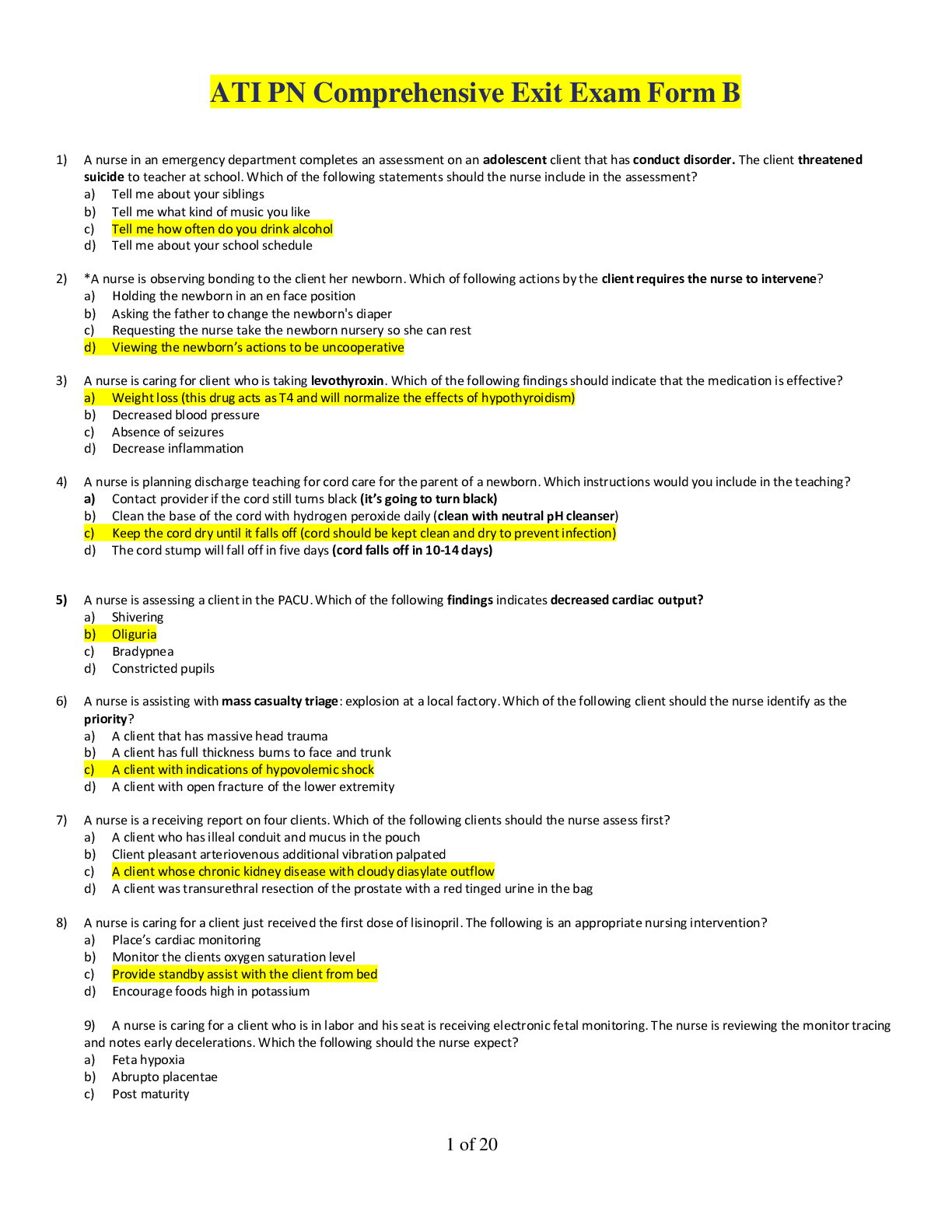
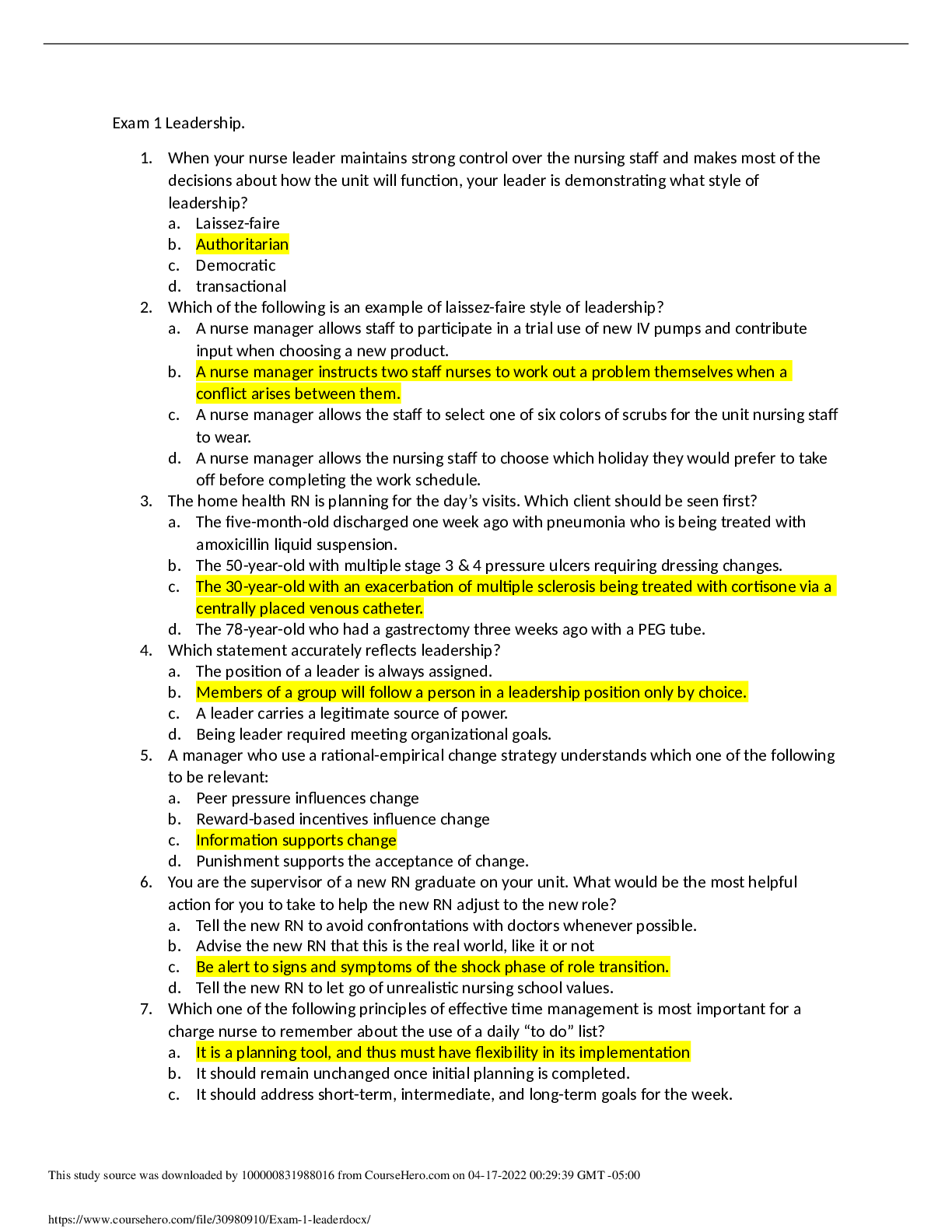


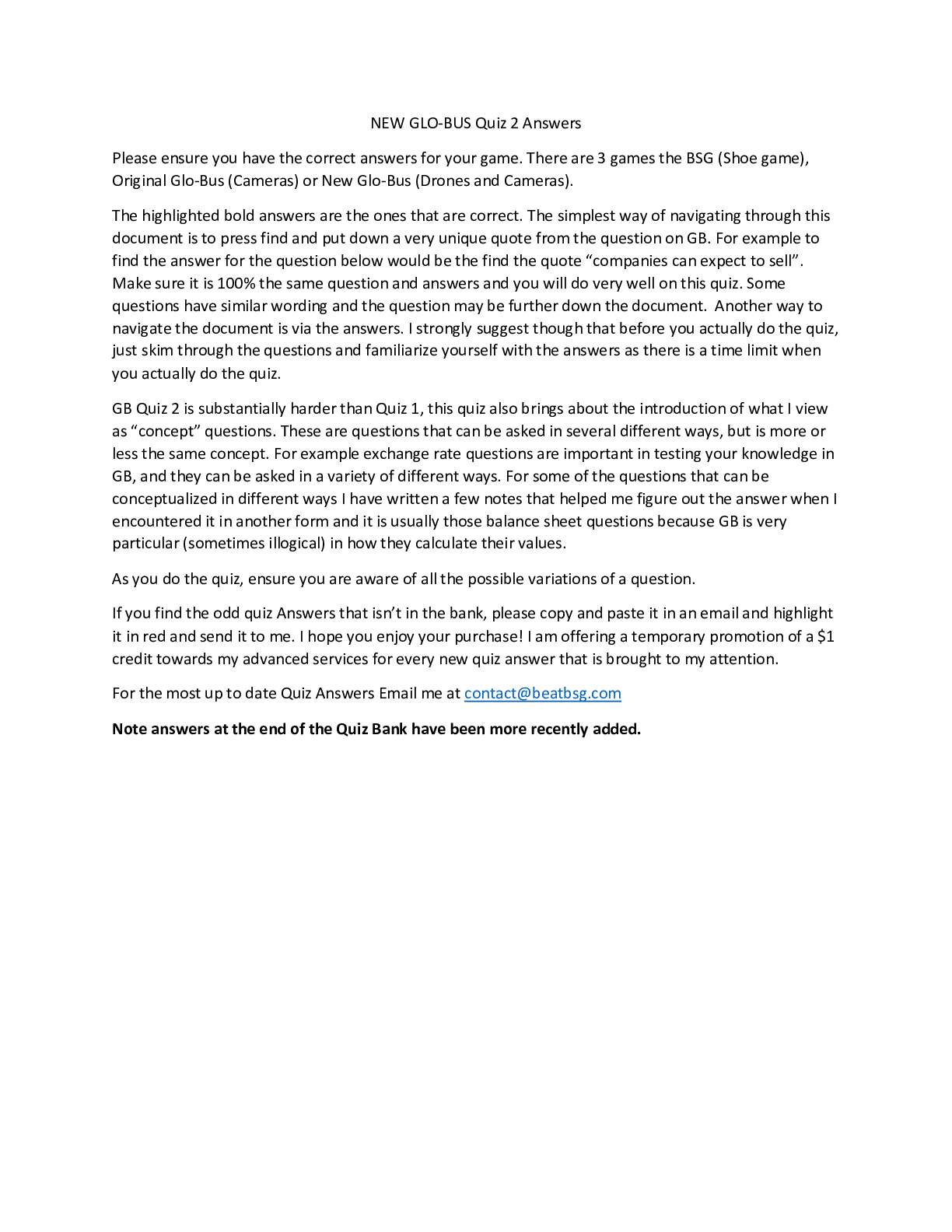
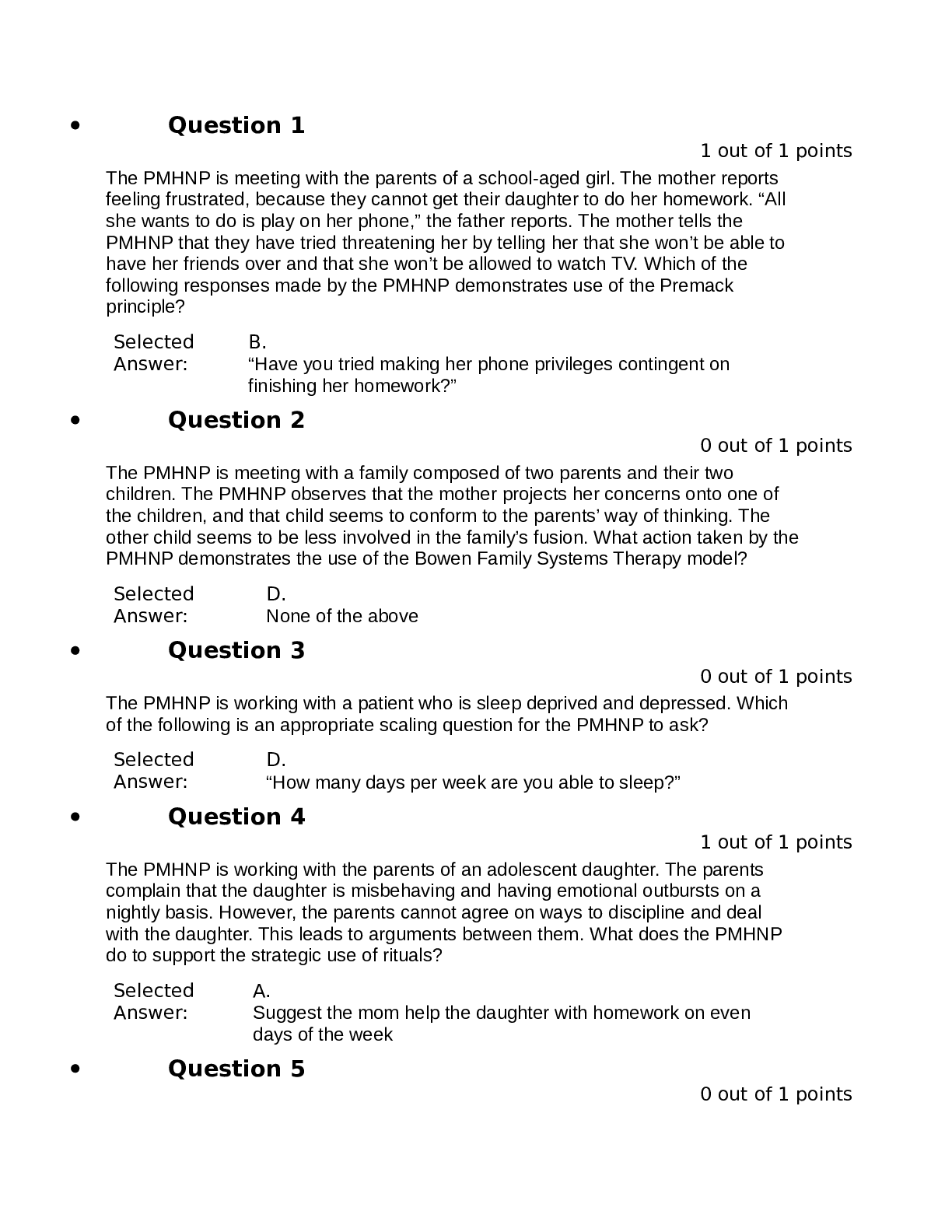
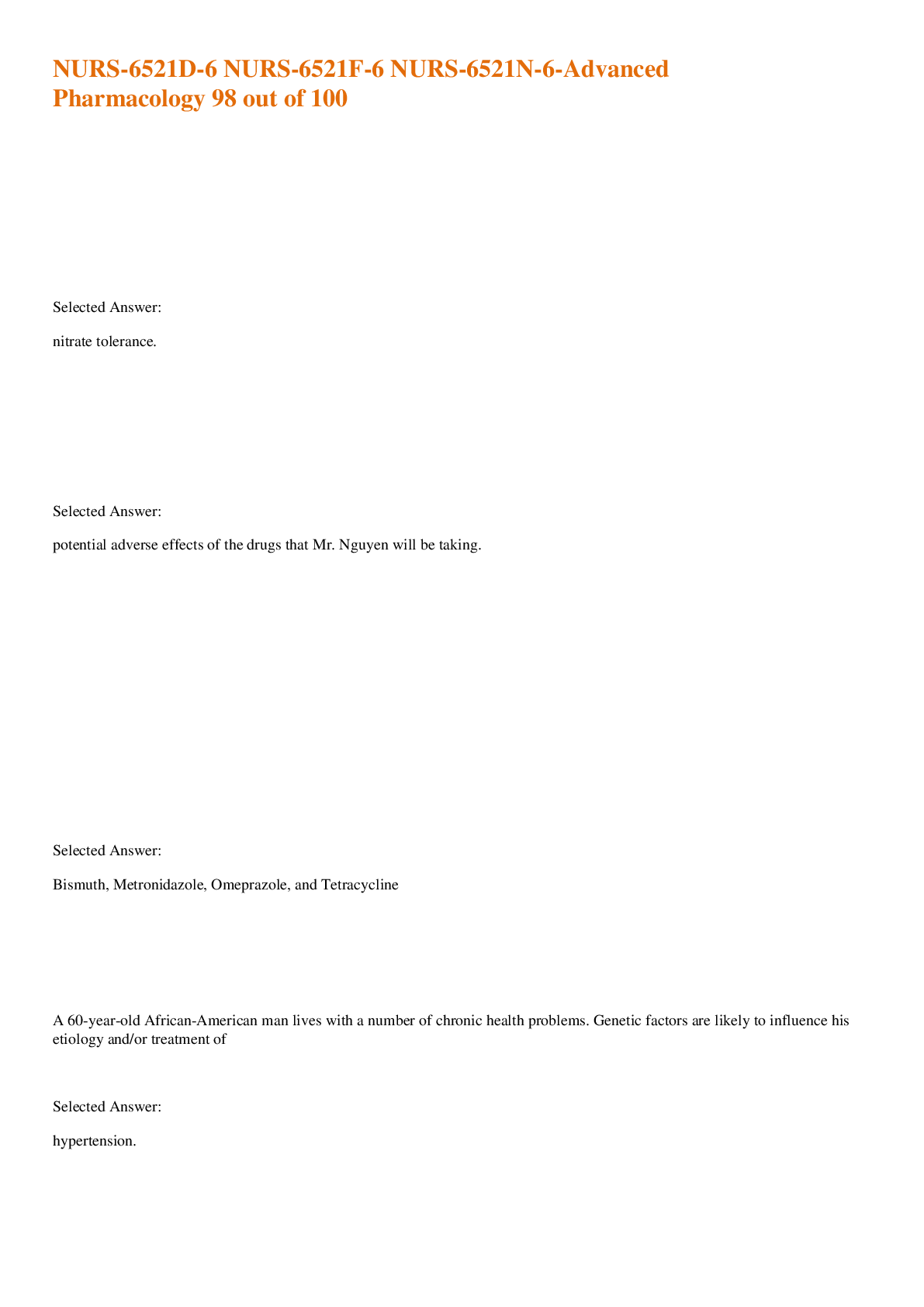
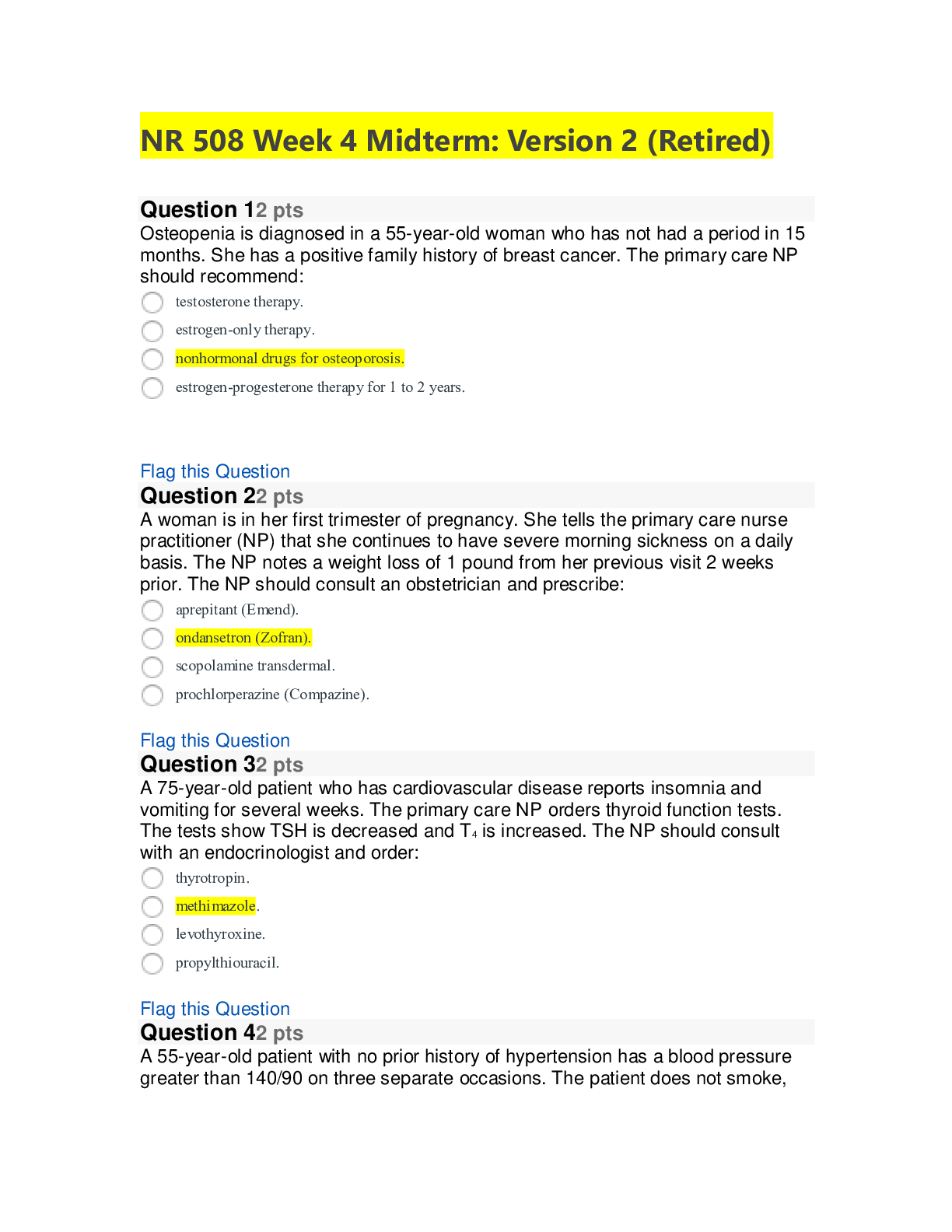



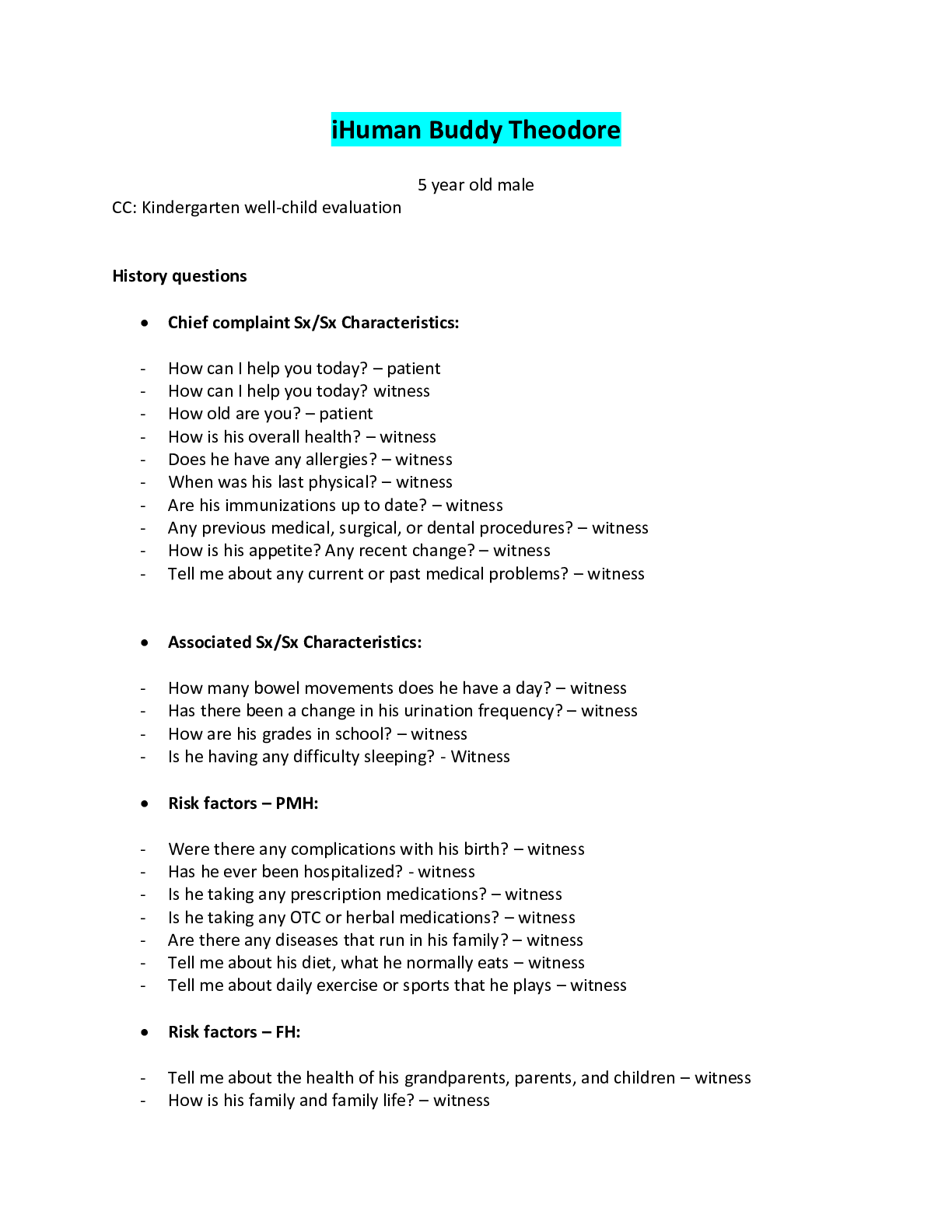

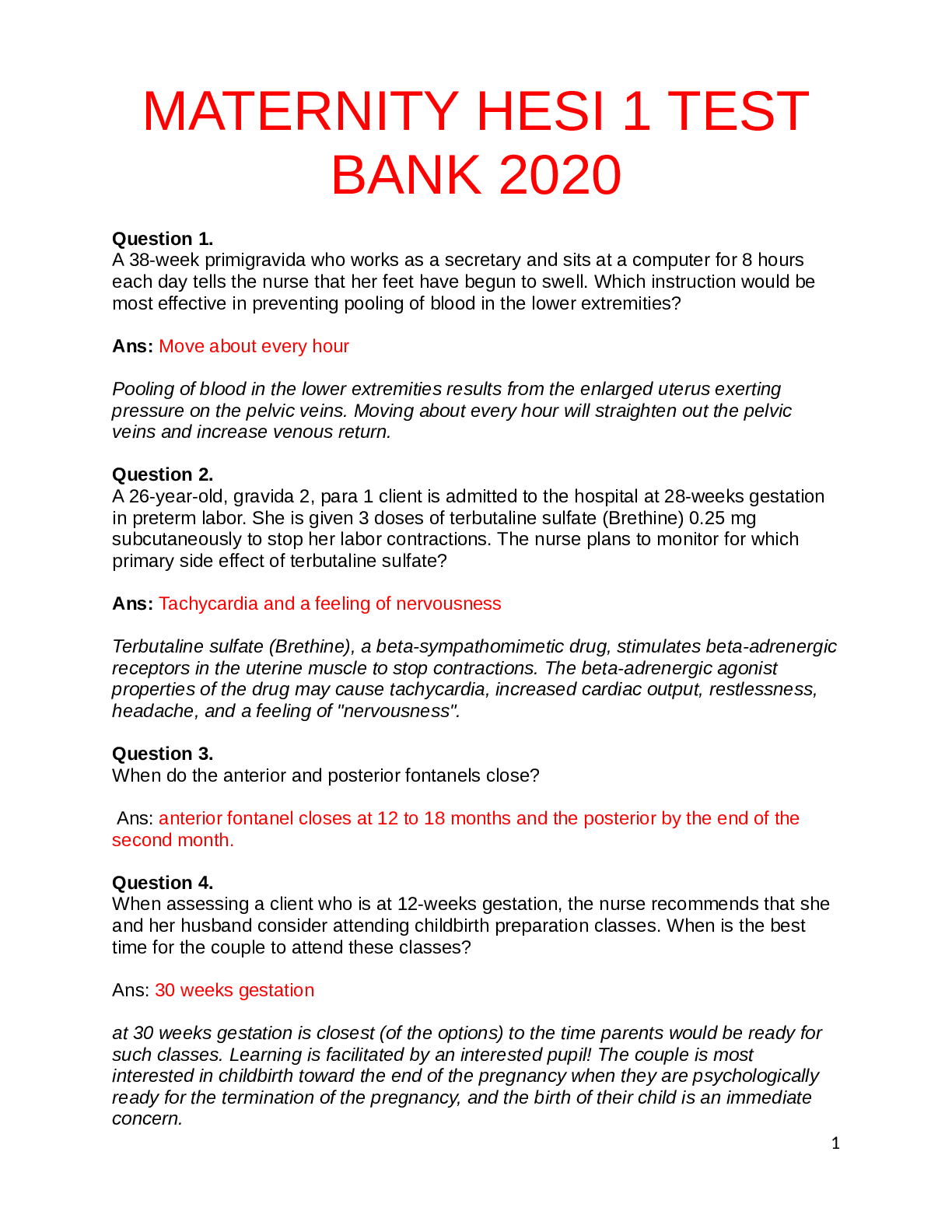
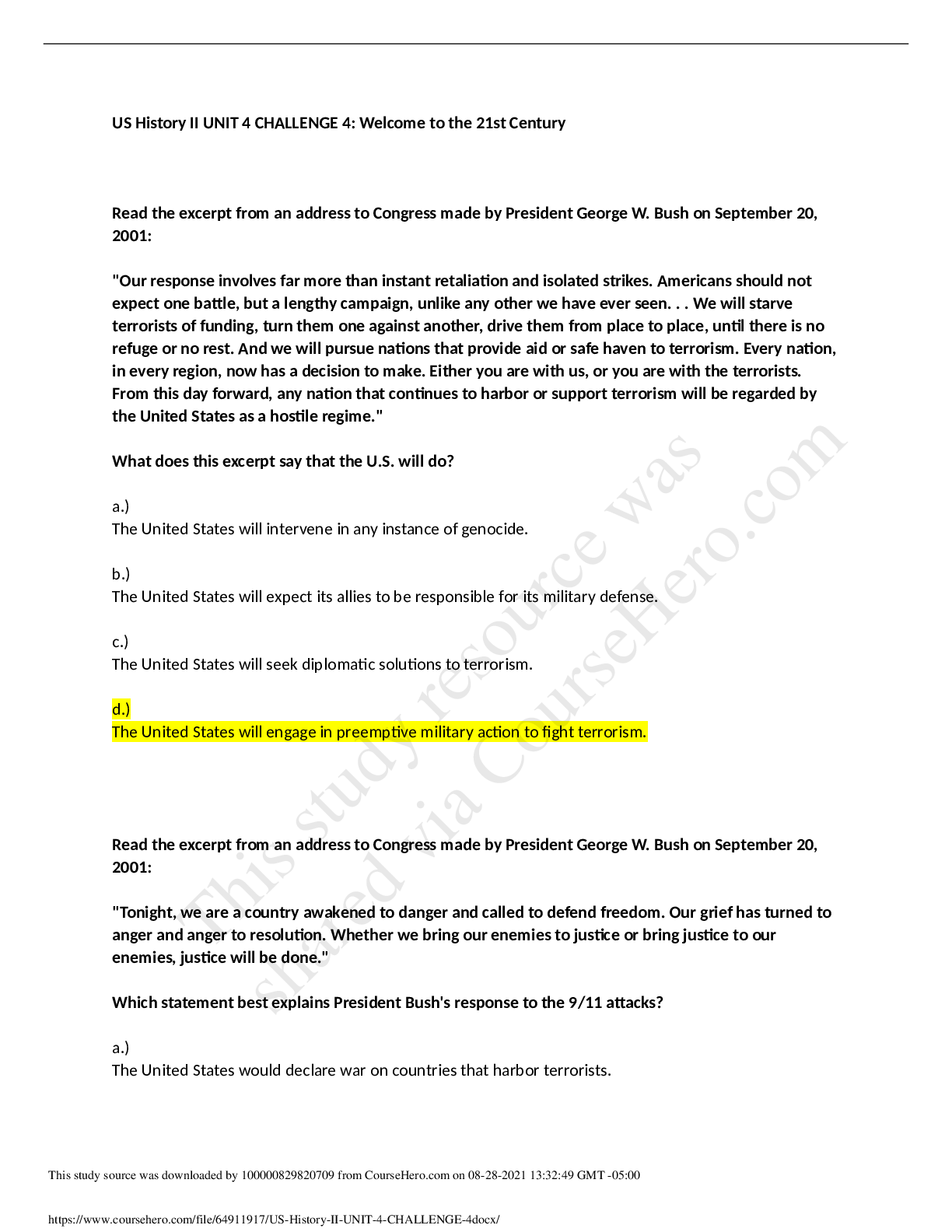
.png)

